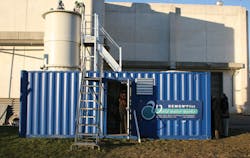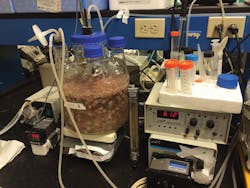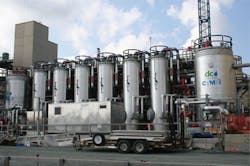Wastewater Industry Gets a LIFT with Collaborate Innovation Program
By Art Haddaway, WaterWorld Editor
Over the last decade, the water industry has gone from merely functioning as a provider of drinking water and wastewater services for municipal and industrial sectors to acting as a resilient powerhouse of innovation and inspiration. This is demonstrated in the rapid rise of water technology incubators and accelerators across the country, where various water experts, businesses and organizations are collaborating to fully embrace creativity and bring about fundamental change.
Such is the case with the Leaders Innovation Forum for Technology (LIFT), a joint initiative between the Water Environment Research Foundation (WERF) and the Water Environment Federation (WEF) that brings together skilled scientists and industry specialists to advance the adoption of cutting-edge trends and technologies in the wastewater field. Further, the program focuses on streamlining water treatment and reclamation processes for end-users while reducing risk and conserving resources.
Launched in November 2012, LIFT accelerates innovation through a wide range of strategies and practices that encompass technological, social and regulatory/policy breakthroughs, as well as through an intensive, groundbreaking, two-pronged research approach that centers on ongoing technology supply and demand. The program also comprises two primary groups of participants -- a working group and a volunteer expert pool -- that help drive LIFT and contribute to the ongoing success of the organization.
"This program is really focused on helping to accelerate that whole process [of development], shrink that timeframe of technology adoption, and help move new technologies into practice more quickly," said Jeff Moeller, director of Water Technologies at WERF. "Our emphasis is focused on debottlenecking the demand side of innovation and working with the end-users to connect them with new technologies."
As leading-edge water clusters continue making their debut across the nation (e.g., The Water Council in Milwaukee and Cincinnati's Confluence Water Technology Innovation Cluster), WERF and WEF are striving to work with these entities, helping to foster the development of new water companies and technologies. The growing influx of these incubators ultimately validates the organizations' efforts as "a movement for demanding more innovation in the water sector -- a groundswell of support to help facilitate it and make it happen," said Moeller.
"I think what we have is a complementary effort. We are working together with many of the clusters that are out there, so we have good relations with them," he said. "Each of those clusters has a different strength that they're drawing from and their own unique technology topics and areas and unique perspectives that they're bringing to the overall efforts. LIFT can help advance those technology providers at a national level … to get their solutions in front of the end-users and facilitate needed testing and demonstrations to help those end-users gain confidence in their use more quickly."
LIFT incorporates a distinct push-pull approach to conducting research and driving modernization in the wastewater field. The "push," or supply, aspect consists of "Technology Scans" that explore the marketplace for innovations and help connect technology providers with interested parties. And the "pull," or demand, aspect comprises seven high-priority focus areas -- green infrastructure, digestion enhancement, biosolids to energy, energy from wastewater, collection systems, shortcut nitrogen removal, and phosphorus recovery -- that have been selected based on survey results and their relevance in the industry today.
The initiative's Technology Scans analyze emerging, pre-commercial or newly commercializing technologies through a three-step approach: Scan & Sort, Basic Technical Review, and Assessment by Interested Parties. As desired by the interested parties, WERF's Targeted Collaborative Research program provides a mechanism to share the cost and risk of conducting a technology demonstration or independent, third-party evaluation. This essentially promotes early adoption of pioneering innovations and enables subscribers to stay informed of these breakthroughs, identify what's involved in investigating a technology and establish peer-to-peer networking and data sharing within the LIFT program.
"We look at technologies that are early in the process but also technologies that are later in the process," said Claudio Ternieden, director of Regulatory Affairs for WEF, during a recent presentation to the Water and Wastewater Equipment Manufacturers Association. "Our ultimate goal [is] having a program that allows the folks to bring the technology -- have them evaluate it and test it -- that then can be accepted in many states … to create the space [so] that technology can be innovative, that technology can move forward. Overall, the results that we're going to see are more technologies coming from the market and being available for utilities across the country."
As part of the Technology Scans, WERF and WEF occasionally release new calls for advanced technologies in an effort to incite inspiration and raise awareness of new projects. "Sometimes we'll do open calls, and they're pretty broad, and sometimes we'll do very targeted calls on a specific topic like dewatering or resource recovery," said Moeller. "We invite technology providers with new innovations to submit their applications to the program."
LIFT's seven focus areas encompass the subjects of energy and nutrients, both of which are of high importance in the current wastewater community. For example, WERF and WEF's first established focus area, shortcut nitrogen removal, as well as their second addition, phosphorus recovery, both concentrate on reducing, better treating or recovering nutrients at wastewater utilities; while biosolids to energy, energy from wastewater, and digestion enhancement all deal with minimizing energy consumption and reclaiming its use at those sites.
Shortcut nitrogen removal and phosphorus recovery, for example, are just two of LIFT's many game-changing focus areas that are transforming the wastewater industry. WERF and WEF are exploring solutions for annamox retention and deammonification efficiency with regard to nitrogen, while also placing emphasis on struvite and calcium precipitation in dealing with phosphorus. These areas are represented through the organizations' recent Nutrient Removal Challenge and Phosphorus Recovery Workshop, where a compendium of critical data and information is being developed to address these issues.
"Much of the nitrogen removal is accomplished by biological treatment processes, but for that process to be effective, it requires a significant amount of energy as well as a significant amount of chemicals," said Amit Pramanik, director of research at WERF. "If you can shortcut that nitrogen removal process, you can reduce significantly the energy required, and you might even eliminate the chemicals required." With phosphorus recovery, "wastewater has valuable commodities that could be monetized, so moving the wastewater community away from [thinking it] is something that needs to be collected, treated and disposed of ... we are trying to close the loop and say that wastewater is actually a resource that can be essentially recovered," he said.
LIFT's research is structured around four vital areas -- Technology Evaluation, People and Policy, Communication, and Informal Forum -- that essentially serve as the lifeblood of the program. Technology Evaluation screens, demonstrates, and shares risk about new technologies, while People and Policy, a WEF-led segment, examines regulatory policies and barriers to these advancements and develops solutions to overcome them. Further, Communication offers participants training, outreach and education for new technologies, while Informal Forum provides a network for end users to share their interests and experiences with new technologies.
"We view the program -- and those four components -- as providing a comprehensive approach to moving innovation into practice. It's technology, people and policy, and the regulatory side, and it's also the network -- all those components are needed to move things forward," said Moeller. Moreover, he noted that these elements allow end-users to show "what they're doing with new technologies, what technologies they're testing and implementing, what data they have developed, what performance information is available, and share that among the agencies."
LIFT ultimately increases the level of service to WERF subscribers, which include municipal and industrial facility owners representing more than 250 organizations nationwide. "The program really complements WERF's research efforts," said Moeller. "WERF funds basic and applied research in the water sector, and LIFT helps extend that effort to new technologies and implementation of new technologies and moving them into practice. I would say it goes beyond technology transfer to technology engagement."
Pramanik added, "LIFT is very well integrated into WERF and WERF research, and it's a win-win for our subscribers and community of wastewater professionals who are able to exchange that information and get up to speed pretty quickly with those technologies and are able to implement those technologies quicker. As we move forward into the next few decades, I think we should be seeing the community here reenergized, not just as stewards of public health, but in a way, we are helping to define the future in [a] resource-constrained world."
In September 2014, WERF and WEF convened a group of water industry thought leaders to expand LIFT and broaden the scope of its many efforts, according to a press release. Dubbed LIFT 2.0, the project will "help foster 'technology highways' between utilities, academics, consultants, and technology providers; prioritize high-reward, multi-beneficial technologies; develop platforms and web applications to support innovation; facilitate and grow a national and international innovation ecosystem; mitigate and manage new technology risk; and identify new regulatory and policy approaches to create the space for innovation."
About the Author

Art Haddaway
Assistant Editor
Art Haddaway is the Assistant Editor of WaterWorld and Industrial WaterWorld magazines. A writer and editor of over 10 years, he has contributed to a variety of regional publications covering everything from current events to creative features. Art is a graduate of Oral Roberts University in Tulsa, Okla., with a bachelor’s degree in print journalism.






